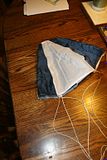edwinshap1
Well-Known Member
- Joined
- Sep 17, 2010
- Messages
- 2,131
- Reaction score
- 3
I was setting up my rocket for an echarge test, and what i found was that i have to run my wire to the back/front end of the tube i want to compress (like the end opposite of what will open up).
i have a 1.5" wide by about 9.5" long tube, and both ends have an eye bolt which take a little space, but they don't take the entire area so stuff (shock cord and wires) can fit.
what is the best method for wrapping a parachute? I can use shock cord to tighten it if necessary.
i have a 1.5" wide by about 9.5" long tube, and both ends have an eye bolt which take a little space, but they don't take the entire area so stuff (shock cord and wires) can fit.
what is the best method for wrapping a parachute? I can use shock cord to tighten it if necessary.
























